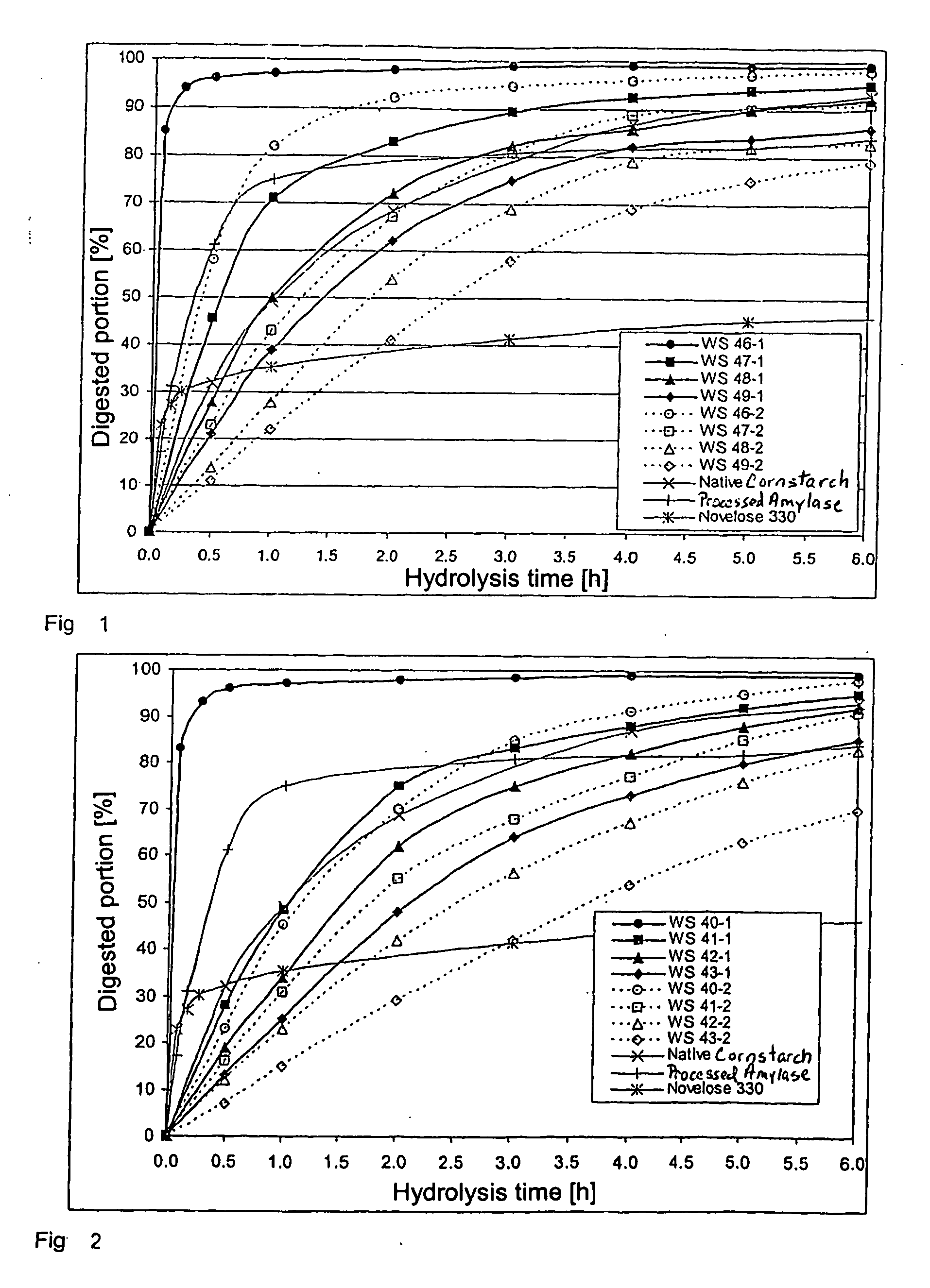Slowly digestible starch product
a technology of starch and slow digestion, which is applied in the field of starch products, can solve the problems of unattractive consumption of native cornstarch in the form of aqueous slurries, rapid rise in blood sugar level, and too great drop in blood sugar level, and achieves low hydrolysis rate, low cost, and sufficient thermal stability.
- Summary
- Abstract
- Description
- Claims
- Application Information
AI Technical Summary
Benefits of technology
Problems solved by technology
Method used
Image
Examples
examples 1
[0045] These examples illustrate the reduction in the initial hydrolysis rate and setting of a constant hydrolysis rate for various recipes, as well as the influence of conditioning parameters. Starch was processed in a Brabender kneader with a 50 ml kneading chamber with water added at speeds ranging from 80-120 RPM to form a thermoplastic compound. The kneading chamber was thermostated to 90° C. In most cases, the starch was used in pregelatinized form, since this enabled a reduction in preparation time. Comparative tests with native starch required a longer processing time, but yielded comparable results with otherwise identical parameters. In mixtures with SCA, the SCA (short-chain, mostly crystalline amylose with an average polymerization level of 24) was mixed with water at a ratio of 1:2, and converted into a low-viscous solution at 160° C. in autoclaves over a period of 5 min. This solution was then supplied at a temperature of roughly 90° C. to the at least partially thermo...
example 2
[0052] This example illustrates the use of the starch product as an ingredient. A reference recipe with 70% wheat flour, 7% butter, 15% isomalt, 5% fructose, 1% salt, 0.8% calcium phosphate, 0.4% malt and 0.8% baking powder relative to dry mass was kneaded into dough at a water content of 28%, and cookies were molded from this. The cookies were baked for 12 min at 210° C. The hydrolysis rate Ho in relation to the starch percentage was determined to be 900% / h. In the reference recipe, a portion of the wheat flour was replaced by a powder according to WS 42-2, so that the recipe contained 45% wheat flour and 25% WS 42-2. The hydrolysis rate Ho relative to the starch percentage was determined to be 600% / h. Therefore, the GI could be reduced in relation to the starch percentage from roughly 88 to 68, or from the high GI range to the medium GI range.
example 3
[0053] This example illustrates the use of the starch product as a food per se, in particular as a potato snack. The same procedure is followed as in Example 1, wherein potato granules and potato flakes in a ratio of 8:2 were used as the basic starch, 1.4% salt was added, the share of SCA relative to the starch as a whole was 20%, and Wo measured 29%. The homogenous mixture was pressed into 0.5 mm thick films, and these films were packed in saran foil and stored at 60° C. for 1 h at a constant Wo. The films were then cut into 1 cm×1 cm pieces and dried at 75° C. to a water content of 10%. At this water content, the pieces were toasted for 1 min in a forced air oven at 220° C. The hydrolysis measurement yielded an Ho of 27% / h (corresponding roughly to a GI value of approx. 15-20), and this value remained constant for roughly 2 h. Therefore, the product has a distinctly slowed release of glucose by comparison to native cornstarch (Ho=64% / h), and is suitable for sustained glucose suppl...
PUM
| Property | Measurement | Unit |
|---|---|---|
| DSC melting point | aaaaa | aaaaa |
| water contents | aaaaa | aaaaa |
| water contents | aaaaa | aaaaa |
Abstract
Description
Claims
Application Information
 Login to View More
Login to View More - R&D
- Intellectual Property
- Life Sciences
- Materials
- Tech Scout
- Unparalleled Data Quality
- Higher Quality Content
- 60% Fewer Hallucinations
Browse by: Latest US Patents, China's latest patents, Technical Efficacy Thesaurus, Application Domain, Technology Topic, Popular Technical Reports.
© 2025 PatSnap. All rights reserved.Legal|Privacy policy|Modern Slavery Act Transparency Statement|Sitemap|About US| Contact US: help@patsnap.com



